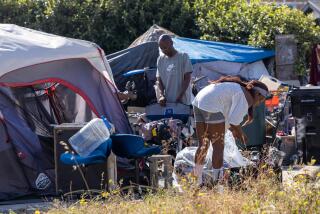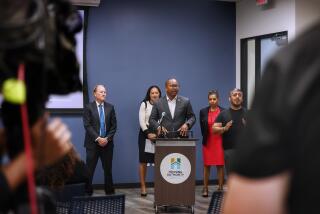How Many Know?
On this Thanksgiving Day in Orange County not everyone will share a holiday feast with friends and relatives. Too many residents have neither the home nor the food, today or any other day.
To date, efforts in the county to help the hungry and the homeless have been fragmented and uncoordinated--encouraging in some areas, disappointing in others.
Missing still is the one major ingredient needed to set loose the energy, commitment and resources that could begin to really make a difference-- community awareness.
How many residents know that tonight about 4,000 men, women and children in the county will go to bed in doorways, parks, restrooms, tents and vacant buildings because throughout all of affluent Orange County there are only about 400 beds available each night for the homeless?
How many residents know that about 320,000 of their neighbors are at risk of going to bed hungry tonight? They’re not all homeless. Or even unemployed. Many of them just have to spend too much of their income for housing, leaving too little for anything else--including food.
The homeless and hungry people for the most part are out of sight and out of mind. But they can’t be placed in convenient categories and dismissed. A survey earlier this year disclosed that most of the homeless have lived in the county for more than 10 years and have a high-school education or better. Some are unable to save the money to pay the advances and deposit needed to rent a place to live. Others have lost jobs or suffered disabling injuries or illnesses. They all need help.
Some of the conditions that have put people on the streets can be changed. More loan funds can be made available to help people meet rental deposits. More temporary beds can be set up to provide overnight shelter.
Government is helping. More than $1.2 million in state money from recent legislation is now coming into the county each year to provide more beds for the homeless. It’s still not enough. And those funds are not being coordinated in any innovative kind of plan that could provide temporary housing for large numbers of homeless people. That would be a likely assignment for the county task force that was created last January by the Board of Supervisors to study the needs of the homeless. But the group is yet to hold its first session.
In another recent display of insensitivity to the plight of the homeless, the county closed the ground-floor restrooms of the county Hall of Administration in Santa Ana to the public after employees complained that bag ladies, and some homeless men, had been using them. The board, however, at Chairman Thomas Riley’s urging, is now working out a compromise.
Housing for some of those bag ladies and other homeless women in the downtown Santa Ana area is on the way in an encouraging sign of enterprise from the private sector, which is financing an addition to the YWCA that will provide overnight lodging for 400 to 500 women a year.
The private sector should be more active--not only in providing such short-term beds but in making more permanent, cheaper-cost housing available, too.
Sometimes government can help by doing nothing. That’s what the Fullerton City Council did last week when it backed away from a staff proposal that would have extended the city’s 8% bed tax to long-term motel and hotel residents, raising rents and forcing some of them into the streets.
Churches are helping. St. Mary’s Episcopal Church in Laguna Beach, for instance, is taking in some homeless people.
More support is also needed for food banks, like the Food Distribution Center of Orange County operated by the St. Vincent de Paul Society. There is ample food in the county. It just needs to be better distributed. Tons of it are thrown away each month while some people tighten their belts and go without. The center is trying to correct that imbalance. It collects, sorts and allocates millions of pounds of surplus and salvageable food to about 170 charitable agencies that distribute it to unfed residents.
Orange County is a community of plenty where income exceeds state and national averages. Its prosperity makes the economic imbalance all the more stark and unnecessary. A community of such visible means and comfort cannot tolerate conditions that allow some of its residents to live without adequate food and shelter. It will be a much poorer place if it does.
More to Read
Sign up for Essential California
The most important California stories and recommendations in your inbox every morning.
You may occasionally receive promotional content from the Los Angeles Times.










